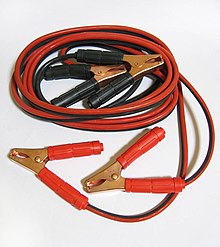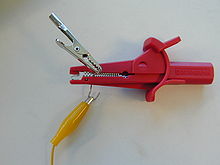Alligator clip


An alligator clip , also known as an alligator clip for short , is used in connection technology in electrical engineering instead of a clamp in experimental setups to quickly establish a detachable electrical connection to an electrical conductor (e.g. wire or component connection).
function
For electrical and mechanical contact, the conductor is gripped by two opposite rows of teeth . Often a row of teeth is narrower, so that the two parts of the bracket rest on each other without a ladder. The teeth are pressed around the conductor by a spring . In the same way z. B. a clothespin .
execution
There are two different versions of these clamps. In the first case, an alligator clip is connected either at one end or at both ends of a line. The second case is an electrical contact clip that has an alligator clip on one side and can be connected directly to a banana plug on the other .
The terminal can be completely uninsulated or plastic-coated, with only the contact area being left free in order to increase the contact safety.
The maximum permissible currents can range from a few mA to several hundred A. Depending on the permissible current, the terminals are implemented with different cross-sections.
Naming
The name of this clamp was derived from the animal kingdom. The shape of an alligator clip with the teeth resembles the snout of a crocodile .
application
Alligator clips are used to quickly make electrical connections, for example in electronics workshops or laboratories . Typical laboratory designs can transmit currents from a few mA to around 15 amperes , depending on the spring force and material .
When used as jump-start cables for the electrical system of internal combustion engines, the mechanical dimensions are significantly larger, the currents can briefly be in the range of several hundred amperes.
safety
Because live parts can be touched on most models, they should either only be used for protective extra-low voltage or only while observing the safety clearances to the terminals. Contacting under electrical voltage is particularly dangerous, as the metal contacts can be touched very easily during use.
In addition, the metal contacts and the connecting line can heat up at high currents, which can melt the line insulation if the quality is insufficient. Like banana plugs , these terminals should therefore only be used by trained personnel.


